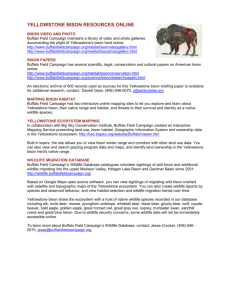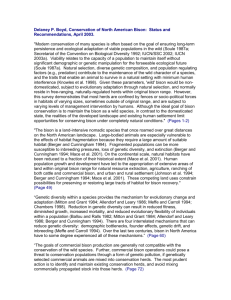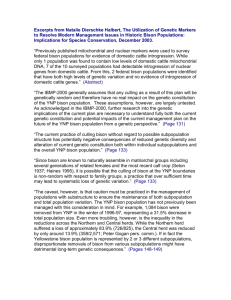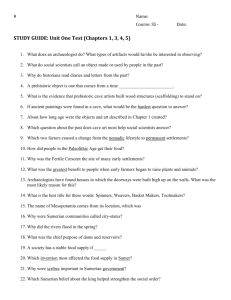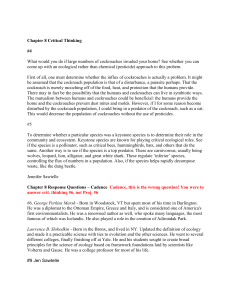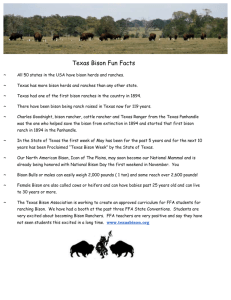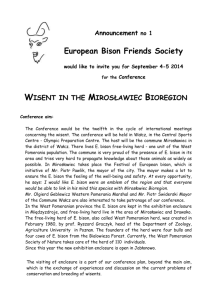US FISH & WILDLIFE SERVICE ENDANGERED SPECIES ACT
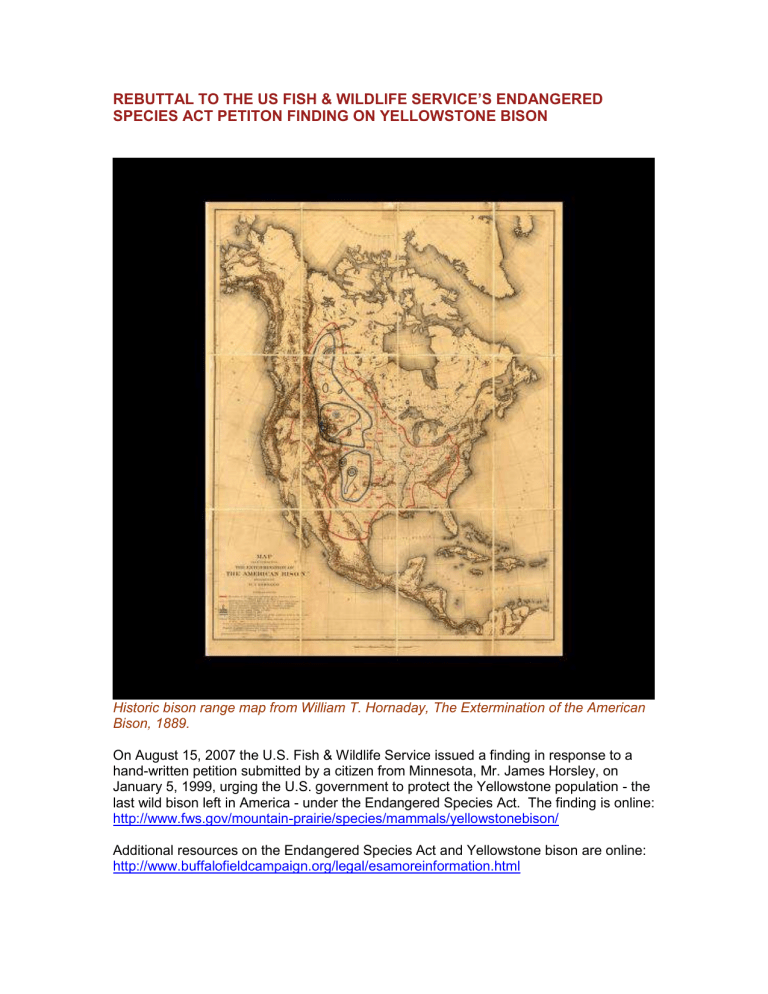
REBUTTAL TO THE US FISH & WILDLIFE SERVICE’S ENDANGERED
SPECIES ACT PETITON FINDING ON YELLOWSTONE BISON
Historic bison range map from William T. Hornaday, The Extermination of the American
Bison, 1889.
On August 15, 2007 the U.S. Fish & Wildlife Service issued a finding in response to a hand-written petition submitted by a citizen from Minnesota, Mr. James Horsley, on
January 5, 1999, urging the U.S. government to protect the Yellowstone population - the last wild bison left in America - under the Endangered Species Act. The finding is online: http://www.fws.gov/mountain-prairie/species/mammals/yellowstonebison/
Additional resources on the Endangered Species Act and Yellowstone bison are online: http://www.buffalofieldcampaign.org/legal/esamoreinformation.html
Buffalo Field Campaign’s Rebuttal to United States Fish & Wildlife Service Finding Not to list Yellowstone Bison as a National Endangered Species.
The U.S. Fish & Wildlife Service's finding does not consider how and by what migratory routes bison originally occupied the Yellowstone Plateau. This is a critical discussion - missing from their finding - regarding the native range of wild bison in the Greater
Yellowstone ecosystem. Without this discussion, the American people, conservationists and the scientific community have no way to independently judge whether bison are endangered “throughout all or a significant portion” of their native range as the
Endangered Species Act requires of the fish and wildlife agency.
Dr. Mary Meagher, Yellowstone National Park's bison biologist for more than 30 years, believes that 10,000 years ago at the end of the last Ice Age, glacial retreat opened up range for bison migrating from surrounding river valleys that followed plant green up to the Yellowstone Plateau (Gates et al. 2005). Yellowstone's unique geothermal features opened winter range for bison to occupy habitat year round (Meagher 1973). Shortly after creation of the world's first national park in 1872, Yellowstone National Park became the last stronghold for the American bison, under armed guard to prevent the species extinction (Meagher 1973; Cope 1885).
Archeological investigations suggest large numbers of bison occupied the Greater
Yellowstone region (Cannon 2001) and that habitat diversity and climatic regimes played an important role in bison distribution, seasonal migration and abundance (Cannon
1997; Williams 2005; Lyman and Wolverton 2002).
From Yellowstone National Park's gateway community in Gardiner to Livingston
Montana, Yellowstone River Valley is one of several river valleys with documented bison jumps and other archaeological evidence of bison inhabiting range that the U.S. Fish &
Wildlife Service did not consider as historic range in its finding:
"The Lamar Valley and the Yellowstone River Valley north of the park
(Figure 4.1) to Livingston and beyond was an important area for bison and Native peoples throughout the Holocene. This system can be considered the original Northern Range for Yellowstone bison, functioning as an ecological continuum of grasslands that likely supported seasonal migrations by bison as far south as the high elevation ranges in the Upper
Lamar Valley. Davis and Zeier (1978:224) described the lower
Yellowstone Valley as an exceptional area for Native people to gather, drive and kill bison. Eight bison jumps and three kill sites have been documented south of Livingston. The closest jump site to YNP is 25 km north of the park boundary. It was used during the late prehistoric period between 1,700 and 200 b.p. (Cannon 1992). There is evidence of a human use corridor from the Gallatin and Madison River drainages into the interior Yellowstone National Park. Several major bison kill sites are located in the Gallatin Valley outside of Bozeman Montana." (Gates et al.
2005)
The U.S. Fish & Wildlife Service's finding fails to consider the biology and natural ecology of bison, their nomadic nature and migratory instinct, knowledge and memory of destination, and the evolutionary significant characteristics of a wild bison herd.
The American bison is a land-intensive species that once roamed over great distances
(Boyd and Gates 2006). Long distance migration, what defines wild bison as a nomadic, herd animal that once thundered across the Great Plains, is in danger of being lost forever.
Berger (2004) examined the "ecological phenomena" of accentuated treks of native ungulates in the Yellowstone ecosystem and found that 100% of historic and current routes for bison have been lost.
Bison corridors and habitat on National Forest lands in the Madison, Gallatin and
Yellowstone river valleys exist (Jourdonnais 2006; Lemke 1997; Lemke 2006) but the
U.S. Forest Service does not manage habitat to sustain populations of wild bison despite its stated forest plan goal of providing "habitat for viable populations of all indigenous wildlife species . . ." (United States Department of Agriculture, Forest Service, Gallatin
National Forest Land and Resource Management Plan, PAGE II-1, 1987).
A "Clean-up Amendment" released in September 2009 by the Gallatin National Forest proposes to remove its Forest Plan goal to "Provide habitat for viable populations of all indigenous wildlife species . . ." The "Clean-up Amendment" is online: http://www.fs.fed.us/r1/gallatin/?page=projects/forest_plan
Furthermore, the Gallatin states its 1987 Forest Plan will not be revised until "2014 or later" resulting in further delay of a decision by the Forest to permanently retire grazing allotments in bison range that have lingered in "vacancy" or “closed” status.
For bison migrating onto Gallatin National Forest lands from Yellowstone National Park, the State of Montana's hunt, capture and slaughter regime awaits them (Bison
Management Plan for the State of Montana and Yellowstone National Park 2000;
Interagency Bison Management Plan 2000).
Migratory corridors and natural selection of habitat is critical to maintaining the
Yellowstone bison herd's habitat and genetic fitness. Yet, these evolutionary significant attributes are being impaired for wild bison in their native range under a governmentfunded plan that has slaughtered over 3,200 bison since 2000.
The U.S. Fish & Wildlife Service also fails to consider that wild bison as a native wildlife species are at risk of genomic extinction.
Circa 1500, American bison now occupy less than one percent of their historic range
(Sanderson et al. 2008) estimated at 9,486,204 square kilometers / 3,662,643 square miles, or 948,620,400 hectares / 2,344,092,058 acres. Today, greater than 95% of the
500,000 bison in North America today reside in private commercial ownership (Boyd
2003). Less than 1.5% of bison are genetically Bison bison (Freese et al. 2007).
Forced cattle-bison breeding experiments to commercially exploit survival attributes of wild bison resulted in widespread introgression of cattle genes in private and public trust bison herds (Polziehn et al. 1995; Ward et al. 1999; Schnabel et al. 2000; Halbert 2003;
Halbert and Derr 2007). Scientists do not know what harmful effects this may have on bison evolution. Derr (2009) sur mises cattle genes change bison’s metabolism and reduce their size and weight
( http://www.nrmsc.usgs.gov/files/norock/GYBRM2009/Derr.pdf
).
The irrevocable point is the cattle genome displaces the bison genome and their offspring are considered a hybrid species.
Current genetic studies identified only 4 populations that can be genetically identified as
Bison bison : Yellowstone National Park, Grand Teton National Park, Sully’s Hill National
Game Preserve, and Wind Cave National Park (Halbert 2003; Halbert and Derr 2007).
The Sully’s Hill and Grand Teton herds were supplemented years ago with hybrid animals. Halbert (2003) and Halbert and Derr (2007) include conflicting information about potential cattle gene introgression in the Wind Cave herd which shares a fence line with Custer State Park bison, a hybrid herd. Bison in Wind Cave are ear-tagged and implanted with a microchip for identification (NPS 2006 http://www.nps.gov/wica/parkmgmt/current-management-plans.htm
)
In the United States, only one wild bison population has continuously occupied their native range since prehistoric time: the Yellowstone bison (Gates et al. 2005).
QuickTime™ and a
decompressor are needed to see this picture.
Distribution of a sample of existing American bison herds across the historical range
(and beyond) in North America. The size of the dots overestimates the actual area occupied. Best estimates are that bison currently occupy <1% of their circa 1500 historical range (modified from Hall & Kelson 1959), shown in red. Major habitat types are indicated by colored areas in the background. (Sanderson 2008)
Loss of genetic diversity stemming from the near extinction of the species (Boyd and
Gates 2006) coupled with extreme loss of historic bison range (Hornaday 1889; Boyd
2003; Sanderson et al. 2008) raises the risk of ecological extinction for wild bison
(Freese et al. 2007).
The extensive prevalence of cattle genes in bison populations (Polziehn et al. 1995;
Ward et al. 1999; Halbert 2003), habitat fragmentation, loss of natural habitats and isolated populations (Boyd 2003), limited range and population sizes, artificial selection, intensive management, unnatural confinement to fenced ranges, absence of predators, introduction of non-native disease (Freese et al. 2007) are some of the risk factors of ecological extinction that the U.S. Fish & Wildlife Service failed to consider in its finding.
Curtis Freese along with several scientists write: "Small herd size, artificial selection, cattle-gene introgression, and other factors threaten the diversity and integrity of the bison genome. In addition, the bison is for all practical purposes ecologically extinct across its former range, with multiple consequences for grassland biodiversity. Urgent measures are needed to conserve the wild bison genome and to restore the ecological role of bison in grassland ecosystems." (Freese et al. 2007)
"Today, the plains bison is for all practical purposes ecologically extinct within its original range." (Freese et al. 2007)
The U.S. Fish & Wildlife Service utterly failed to discuss the ecological importance of bison and the vital, keystone role they play in maintaining ecosystem health and function.
The U.S. Congress had intended that the national Endangered Species Act protect not only endangered species but the ecosystem they reside in: "to provide a means whereby the ecosystems upon which endangered species and threatened species depend may be conserved."
( http://www4.law.cornell.edu/uscode/html/uscode16/usc_sec_16_00001531----000-.html
)
Extirpation of bison from their native range is an indicator that the prairie ecosystem they played a central role in forming is also at risk of extinction (Knapp et al. 1999).
"Knowledge of the bison's role in tallgrass prairies is lacking because the extent of this grassland and the abundance of its dominant ungulate have declined dramatically and in tandem over the last 150 years." (Knapp et al. 1999)
In 2000 the Wildlife Society accurately characterized the perilous status of bison in
Montana in a resolution passed by its scientists:
"Bison were a keystone species of the prairie ecosystem; significantly affecting the way the prairie grassland ecosystem evolved and playing an important role in maintaining it. Wild bison remain ecologically extinct in
Montana. The State of Montana Department of Livestock has prevented the natural dispersal of wild bison into Montana from Yellowstone National Park because of disease issues while no attempts are underway to restore the species outside of this controversial region. Current management of private, state and Federal bison herds is leading towards domestication of bison that threatens their wild character and limits important natural selection
processes."
Bison group along Old Yellowstone Trail, Gardiner Basin, Montana, January 2008.
Darrell Geist photo
Crucially, grazing by bison can reverse the loss of native grassland species and the disruption of grassland ecosystem structure and function caused by their extirpation
(Collins et al. 1998).
The U.S. Fish & Wildlife Service puts an unfounded faith in the "contingency measures" of the Interagency Bison Management Plan and its "successful management" to prevent the loss of the Yellowstone bison population.
The on-going slaughter of large numbers of wild bison by the state of Montana and U.S.
National Park Service may threaten the genetic viability and integrity of the Yellowstone bison herd's population structure as revealed by several scientific studies (Halbert 2003;
Christianson et al. 2005; Olexa and Gogan 2007; Gardipee 2007).
These policies have dire consequences for bison according to Halbert (2003):
"The current practice of culling bison without regard to possible subpopulation structure has potentially negative consequences of reduced genetic diversity and alteration of current genetic constitution both within individual subpopulations and the overall YNP [Yellowstone
National Park] bison population."
Scientists have also identified distinct breeding grounds that help maintain genetic diversity within the Yellowstone bison herd (Gardipee 2007; Olexa and Gogan 2007).
However, there is no evidence that the interagency plan has considered bison population structure in its management decisions and actions (Peter Gogan U.S.
Geological Service pers. comm.).
Loss of entire matrilineal bison groups, who have fidelity to natal sites and rutting territory, could alter and limit knowledge of destination and migratory routes retained for each bison population in Yellowstone. Halbert writes (2003):
"Since bison are known to naturally assemble in matriarchal groups including several generations of related females and the most recent calf crop (Seton 1937; Haines 1995), it is possible that the culling of bison at the YNP boundaries is non-random with respect to family groups, a practice that over sufficient time may lead to systematic loss of genetic variation."
In a March 23, 2008 New York Times article, “Anger Over Culling of Yellowstone’s
Bison,” Dr. James Derr, Texas A & M University, expressed concern that bison behaviors and traits including migration could be lost in the on-going bison slaughter.
"The greatgrandmother, grandmother, mother and daughter often travel together,” said
Derr, adding that killing bison “is like going to a family reunion and killing off all of the
Smiths.” This would affect “the genetic architecture of the herd,” Derr said.
Yellowstone National Park and the several federal and state agencies involved in executing the Interagency Bison Management Plan have not adapted to emerging science on Yellowstone bison herd dynamics, ecology and population structure (Peter
Gogan U.S. Geological Service pers. comm.), raising the risk that irreversible genetic harm may have already occurred or is taking place within America's last herd of wild bison.
Scientist Natalie Halbert (2003) has emphasized that "… caution must be practiced in the management of populations with substructure to ensure the maintenance of both subpopulation and total population variation. The YNP bison population has not previously been managed with this consideration in mind. For example, 1,084 bison were removed from YNP in the winter of 1996-97, representing a 31.5% decrease in total population size. Even more troubling, however, is the inequality in the reductions across the Northern and Central herds. While the Northern herd suffered a loss of approximately 83.9% (726/825), the Central herd was reduced by only around 13.9%
(358/2,571; Peter Gogan pers. comm.). If in fact the Yellowstone bison population is represented by 2 or 3 different subpopulations, disproportionate removals of bison from various subpopulations might have detrimental long-term genetic consequences."
Wildlife Biologist D.J. Schubert wrote that at a May 21, 1998 meeting of the Greater
Yellowstone Interagency Brucellosis Committee, Dr. Joe Templeton, Texas A&M
University, summarized a bison genetics study on species surviving nearing extinction.
Dr. Templeton reported, “every animal which is removed from the breeding population can no longer contribute to the genetic variability of the herd.” He cautioned the agencies that:
“The so called “random” shooting at the Montana’s borders is actually eliminating or depleting entire maternal lineages, therefore this action will cause an irreversible crippling of the gene pool. Continued removal of genetic lineages will change the genetic makeup of the herd, thus it will not represent the animals of 1910 or earlier.”
At the same meeting, Dr. James Derr, Texas A&M University, summarized a bison genetics study on genetic variation in extant and historical bison populations. Dr. Derr reported that the discovery, also reported by Dr. Templeton, of naturally occurring resistance to brucellosis might provide a viable long-term solution to the present bison controversy. He cautioned that “in order to fully explore this option (of a naturally
occurring resistance to brucellosis) it is important to not reduce the bison population levels any further and risk the elimination of these disease resistant genes” and that “we should know the genetic makeup of bison before management decisions are made which may compromise the future of bison genetic health.”


